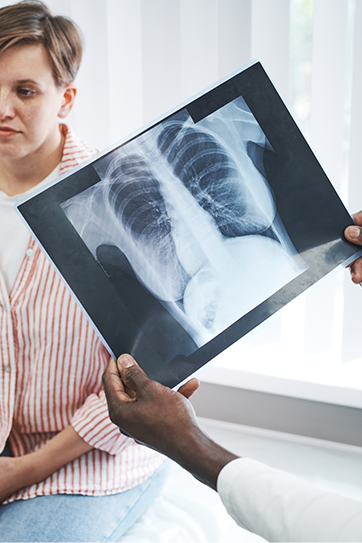Lung cancer is a type of cancer that usually originates in lung cells, causing uncontrolled cell growth.
It is one of the most common cancer types worldwide and is often associated with smoking habits. However, non-smokers can also develop lung cancer. Since lung cancer is often diagnosed in advanced stages, preventive measures are crucial.
Risk reduction can be achieved through measures such as avoiding smoking, avoiding passive smoking, adopting a healthy lifestyle, and undergoing regular health check-ups. Early diagnosis and appropriate treatment can effectively manage lung cancer, but it is generally a serious cancer type that significantly affects prognosis.
Symptoms of lung cancer typically manifest in advanced stages of the disease and may unfortunately not be noticeable in early stages. Therefore, patients often receive a diagnosis at a more advanced stage when symptoms become apparent. Symptoms of lung cancer may include:
Symptoms can vary from person to person and may also indicate other health issues. Therefore, when a significant symptom is noticed, it is important to consult a healthcare professional in the relevant field for a detailed evaluation.
Lung cancer is generally classified into two main types: small-cell lung cancer (SCLC) and non-small cell lung cancer (NSCLC). These two main categories encompass tumors with different cell structures and growth characteristics.
Small Cell Lung Cancer (SCLC)
Non-Small Cell Lung Cancer (NSCLC)
Non-small cell lung cancer is generally a more common type and includes three subtypes: squamous cell carcinoma, adenocarcinoma, and large cell carcinoma. These subtypes have different cell structures and origins.
Such classifications play a significant role in treatment planning and prognosis determination. The diagnosis and treatment of lung cancer are personalized based on the type of tumor, its stage, and the patient's overall health.
The diagnosis of lung cancer is typically established through various medical tests and imaging methods. Initially, simple imaging tests like chest X-rays can identify lesions. However, for more detailed and accurate results, computed tomography (CT) scans are often preferred, as they provide a clearer view of small lesions or tumors in the lungs.
Bronchoscopy and biopsy methods also play a crucial role in the diagnostic process. Bronchoscopy involves using a flexible tube to enter the airways and obtain tissue samples from abnormal areas. These samples are sent to the laboratory for pathological examination, determining the type and characteristics of the cancer.
Sputum analysis is a test that investigates the presence of cancer cells in a patient's sputum (phlegm). However, it may not be sufficient on its own for diagnosing cancer and is often used in conjunction with other tests. Positron Emission Tomography (PET) scanning is an imaging technique that shows metabolic activity in the body and can help determine how much the cancer has spread. Lastly, blood tests and tumor markers may also be used, but these are evaluated in conjunction with other methods to confirm the diagnosis.
The treatment of lung cancer is generally personalized based on the type of tumor, its stage, the patient's overall health, and other factors. The treatment plan is determined by a multidisciplinary healthcare team and often involves a combination of multiple treatment methods. In cases where small tumors are detected early, and the cancer is localized to one area of the lung, surgical intervention is often preferred. These surgeries aim to remove the tumor and surrounding healthy tissues.
In cases of advanced or unsuitable for surgery, radiation therapy may be used. High-energy rays target and kill cancer cells. Radiation therapy can be used to shrink the tumor, target a specific area, or eliminate remaining cells after surgery. Chemotherapy involves using drugs that kill or stop the growth of cancer cells. As a systemic treatment, it targets cancer cells circulating in the body. Chemotherapy can be used to shrink tumors before surgery, reduce the risk of recurrence after surgery, or in cases where cancer has spread.
Targeted therapies focus on tumors with specific genetic changes. These therapies are usually determined based on biopsy results and focus on the specific characteristics of tumor cells. Immunotherapy is a treatment method that enhances the body's immune system to fight against cancer cells. It can be effective in certain types of lung cancer. In some cases, participating in clinical trials to evaluate new and experimental treatment methods may also be an option. For the 2024 lung cancer treatment costs and more detailed information, contact Medwide.




Get practical information about the topics you are most curious about. Everything you need to make informed decisions on your beauty and health journey is here with all the details from A to Z.
Smoking is the most significant risk factor for lung cancer. Adopting a non-smoking lifestyle can significantly reduce the risk of lung cancer. A balanced and healthy diet can improve overall health and reduce the risk of cancer. Regular health check-ups for individuals at risk can increase the chances of detecting cancer in its early stages.
The success rate of lung cancer treatment varies depending on numerous factors. Surgical intervention can be successful in small tumors detected in early stages. However, in advanced stages, where cancer is detected late, treatment can be challenging, and success rates may decrease. Factors affecting treatment success include tumor type, stage, overall health of the patient, and treatment methods used.
Various side effects may arise during lung cancer treatment, depending on the methods used. Post-surgery pain, skin problems during radiation therapy, nausea, and hair loss due to chemotherapy are common side effects. Targeted therapies and immunotherapy may also have specific side effects. However, each patient is unique, and side effects can vary individually. Patients should be thoroughly informed about these side effects when planning their treatment. Side effects are generally manageable, and doctors can take necessary measures to improve the patient's quality of life.
Medwide meticulously arranges airport transfers for patients and their companions, ensuring their comfort and satisfaction.
Medwide's VIP transfer service offers patients a personalized and privileged travel experience, providing exceptional service.
Medwide transports patients and their companions comfortably and luxuriously, making their journeys enjoyable and relaxing.
Medwide offers quality healthcare services to patients at affordable prices, ensuring transparency and fairness in costs.
Medwide provides fast treatments by reducing patient wait times, our expert doctors promptly respond to our patients' needs.